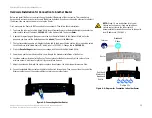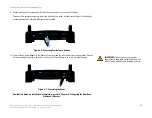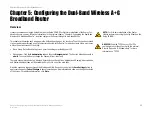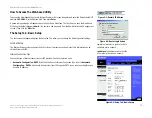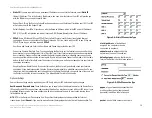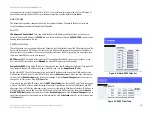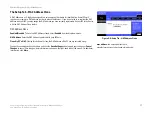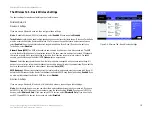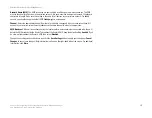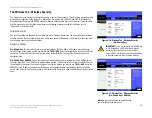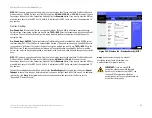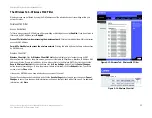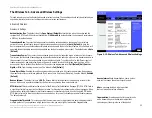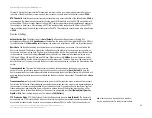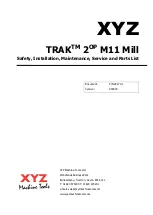
24
Chapter 5: Configuring the Dual-Band Wireless A+G Broadband Router
The Wireless Tab - Advanced Wireless Settings
Dual-Band Wireless A+G Broadband Router
Threshold. Setting the Fragmentation Threshold too low may result in poor network performance. Only minor
reduction of the default value is recommended. In most cases, it should remain at its default value of
2346
.
RTS Threshold
. Should you encounter inconsistent data flow, only minor reduction of the default value,
2346
, is
recommended. If a network packet is smaller than the preset RTS threshold size, the RTS/CTS mechanism will
not be enabled. The Router sends Request to Send (RTS) frames to a particular receiving station and negotiates
the sending of a data frame. After receiving an RTS, the wireless station responds with a Clear to Send (CTS)
frame to acknowledge the right to begin transmission. The RTS Threshold value should remain at its default value
of
2346
.
Wireless-G Settings
Authentication Type
. The default is set to
Auto (Default)
, allows either Open System or Shared Key
authentication to be used. With
Open System
authentication, the sender and the recipient do NOT use a WEP key
for authentication. With
Shared Key
authentication, the sender and recipient use a WEP key for authentication.
Basic Rate
. The Basic Rate setting is not actually one rate of transmission but a series of rates at which the
Router can transmit. The Router will advertise its Basic Rate to the other wireless devices in your network, so
they know which rates will be used. The Router will also advertise that it will automatically select the best rate
for transmission. The default setting is
Default
, when the Router can transmit at all standard wireless rates
(1-2Mbps, 5.5Mbps, 11Mbps, 18Mbps, and 24Mbps). Other options are
1-2Mbps
, for use with older wireless
technology, and
All
, when the Router can transmit at all wireless rates. The Basic Rate is not the actual rate of
data transmission. If you want to specify the Router’s rate of data transmission, configure the Transmission Rate
setting.
Transmission Rate
. The rate of data transmission should be set depending on the speed of your wireless
network. You can select from a range of transmission speeds, or you can select
Auto (Default)
to have the
Router automatically use the fastest possible data rate and enable the Auto-Fallback feature. Auto-Fallback will
negotiate the best possible connection speed between the Router and a wireless client. The default value is
Auto
(Default)
.
Transmission Power
. The greater the transmission power used, the larger the area a wireless network covers.
To minimize the likelihood of eavesdropping by unauthorized wireless users, do not use more transmission power
than necessary to cover the range needed by your wireless network. Try using the Router at different levels of
transmission power, and determine how much power is needed to reach the wireless client, such as a PC or
access point, that is farthest from the Router. Then select the appropriate level,
Full (Default)
,
Half
,
Quarter
,
Eighth
, or
Min
, from the drop-down menu. The default is
Full (Default)
.
CTS Protection Mode
. CTS (Clear-To-Send) Protection Mode should be set to
Auto
(Default)
. The Router will
automatically use CTS Protection Mode when your Wireless-G products are experiencing severe problems and
are not able to transmit to the Router in an environment with heavy 802.11b traffic. This function boosts the
cts
(clear to send): a signal sent by a wireless
device, signifying that it is ready to receive data.

